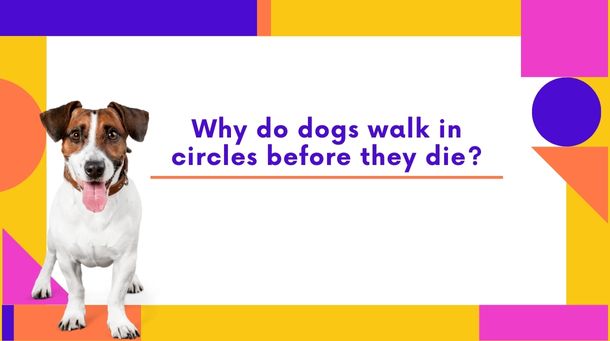Why do dogs walk in circles before they die
The behavior of dogs walking in circles before they die is a phenomenon that has puzzled pet owners and veterinarians for years. While not all dogs exhibit this behavior, they commonly pace in circles in their final hours.
Some people believe this behavior is a sign of the dog’s consciousness fading away, while others think it is an instinctual behavior that is hardwired into dogs.
Understanding why dogs walk in circles before they die can help pet owners cope with losing their beloved companions and provide a more peaceful end-of-life experience for their furry friends. This article will explore why dogs exhibit this behavior and what it means for the dog and its owners.
Do Dogs Walk Around in Circles Before They Die?
Some dogs may walk around in circles before they die, but not all dogs exhibit this behavior. The reasons behind this behavior are not fully understood, but it is believed to be related to a combination of instinctual, neurological, and psychological factors.
Instinctually, dogs may circle before resting, even in their final hours. Neurologically, dogs near death may experience disorientation or loss of balance, which could contribute to this behavior.
Psychologically, anxiety or restlessness could also cause dogs to walk around in circles before they die.
While this behavior is not always present in dying dogs, it is not uncommon and understanding its possible causes can help pet owners provide comfort and support to their furry companions in their final moments.
Why Do Dogs Walk in Circles Before They Die?
The behavior of dogs walking in circles before they die is not fully understood, but several possible explanations exist. One reason for this behavior may be instinctual, as dogs in the wild often circle before settling into a comfortable resting spot.
Another reason may be neurological, as dogs near death may experience disorientation or loss of balance, causing them to pace in circles. Psychological factors like anxiety or restlessness may also contribute to this behavior.
While not all dogs exhibit this behavior, understanding why dogs walk in circles before they die can help pet owners provide comfort and support to their furry friends in their final moments.
What Should You Do About Your Dog Walking In a Circle?
If your dog is walking in circles, you should observe its behavior to see if any other symptoms are present.
If your dog exhibits other symptoms, such as loss of balance, head tilt, vomiting, or loss of appetite, you should take them to the vet as soon as possible.
If no other symptoms are present and your dog is otherwise healthy, it may be normal behavior, especially if they circulate before lying down to rest.
However, if the behavior is excessive or persistent, taking your dog to the vet for a check-up is still a good idea to rule out any underlying medical conditions.
In addition to seeking medical attention if necessary, you can try to provide your dog with a comfortable and safe environment.
Ensure they have a cozy and quiet spot to rest, and provide plenty of fresh water and a balanced diet to keep them healthy. If your dog shows signs of anxiety or stress, you may consider consulting with a professional dog trainer or behaviorist to address any underlying behavioral issues.
What Do Dogs Do When They Know They’re Dying?
Determining what dogs know or understand about their impending death is difficult. However, some common behaviors dying dogs may exhibit. For example, they may become more withdrawn and less active, losing interest in activities they once enjoyed.
They may also stop eating or drinking and have difficulty breathing or moving. Some dogs may seek solitude and privacy, while others may become clingier and seek comfort from their owners.
Additionally, some dogs may exhibit physical symptoms, such as vomiting or seizures, as their body begins to shut down.
While it is impossible to know exactly what a dying dog is experiencing, it is important for pet owners to be aware of these common behaviors and to provide their dogs with comfort, support, and love in their final days.
When Should You Be Concerned About Your Dog’s Circling?
If your dog is circling more than usual or exhibiting other unusual behaviors, it may be a cause for concern. Some signs that may indicate a more serious underlying condition include:
- If your dog is having difficulty walking or standing or is falling over, it may indicate a neurological issue.
- A head tilt could indicate an ear infection, vestibular disease, or a brain tumor.
- If your dog is also experiencing other symptoms, such as vomiting or a loss of appetite, it could be a sign of a more serious condition.
- It could be a sign of a more serious condition if your dog exhibits other unusual behaviors, such as lethargy, aggression, or disorientation.
If you notice these symptoms, taking your dog to the vet as soon as possible is important. Early diagnosis and treatment can help manage the underlying condition and improve your dog’s quality of life.
What Medical Conditions Could Cause My Dog to Walk in Circles?
Several medical conditions could cause a dog to walk in circles. Some of the most common conditions include the following:
- Vestibular Disease: This condition affects the inner ear and can cause a dog to lose balance and walk in circles.
- Brain Tumor: A tumor in the brain can disrupt normal brain function, leading to neurological symptoms such as circles.
- Ear Infection: An ear infection can also affect a dog’s balance and cause them to walk in circles.
- Stroke: A stroke can damage the brain and cause neurological symptoms, including circles.
- Seizures: Seizures can cause dogs to lose control of their bodies and walk in circles.
- Arthritis: Arthritis can make it difficult for a dog to move normally, and they may walk in circles to compensate for the pain or discomfort.
- Intoxication: Ingesting toxic substances can cause various symptoms, including disorientation and circling.
When to Seek Professional Help for Your Dying Dog’s Behaviors?
As a pet owner, it can be difficult to determine when to seek professional help for your dying dog’s behavior.
Here are some signs that may indicate it’s time to seek the help of a veterinarian or other animal care professional:
- Loss of Appetite: If your dog refuses to eat or drink, it can be a sign of pain or discomfort.
- Difficulty Breathing: If your dog is having difficulty breathing or is breathing rapidly, it could be a sign of respiratory distress.
- Changes in Behavior: If your dog acts differently than usual, such as becoming more withdrawn or exhibiting aggression, it could be a sign of underlying pain or discomfort.
- Incontinence: If your dog has accidents in the house or cannot control their bladder or bowels, it may be time to seek professional help.
- Severe Pain: If your dog shows signs of severe pain, such as whining, crying, or yelping, it may be time to seek medical attention.
Other Reasons Dogs Could Walk Around in Circles:
- Instinctual behavior
- Nervousness or anxiety
- Boredom or excess energy
- Obsessive-Compulsive Disorder
- Ear infections
- Neurological disorders
- Toxicity
- Age-related changes
- Trauma
How to Comfort and Support Your Dog as They Walk in Circles Before Passing Away?
Losing a beloved pet is never easy, and it can be especially difficult to watch them suffer in their final days. If your dog is walking in circles before passing away, here are some ways you can comfort and support them:
- Provide a comfortable and quiet space: Create a quiet and comfortable space for your dog to rest and feel secure. This may include a cozy bed, soft blankets, and dim lighting.
- Offer plenty of water: Keep a bowl of fresh water close by and ensure your dog can always access it. Dehydration can worsen your dog’s condition and make them feel more uncomfortable.
- Provide food and treats: If your dog can still eat, offer them small amounts of their favorite food and treats. However, don’t force them to eat if they have lost their appetite.
- Give them gentle pets and strokes: Gently pet and stroke your dog, speaking softly and reassuringly to them. This can help to calm them and make them feel loved and cared for.
- Consider pain management: Talk to your veterinarian about options to help ease your dog’s discomfort. This may include medication or other treatments.
- Be present: Your dog will feel comforted by your presence, so try to spend as much time with them as possible. You can read a book, listen to music, or sit quietly with your dog.
Remember that every dog is unique and may require different comfort and support. Trust your instincts and do what is best for your dog in its final days.
Conclusion
While circling behavior in dogs can be an instinct or a harmless habit, it can also be a sign of an underlying medical condition or illness.
If you notice your dog circling excessively or exhibiting other concerning symptoms, it is important to seek the advice of a veterinarian or animal behaviorist.
Additionally, it is important to monitor your dog’s behavior as they near the end of their life and to seek support and guidance from a professional to ensure their comfort and well-being during this difficult time.
Why do dogs walk in circles before they die? Why do dogs walk in circles before they die? Why do dogs walk in circles before they die? Why do dogs walk in circles before they die? Why do dogs walk in circles before they die? Why do dogs walk in circles before they die? Why do dogs walk in circles before they die? Why do dogs walk in circles before they die? Why do dogs walk in circles before they die? Why do dogs walk in circles before they die? Why do dogs walk in circles before they die? Why do dogs walk in circles before they die?




